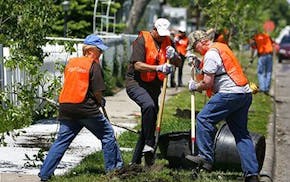The Rev. Bryce Johnson wielded the razor blade with what might be called a sense of righteous purpose, slashing each mound of bread dough with a particular pattern. On one, the cuts looked like tic-tac-toe; on another, a half-moon. ¶ "How about yours, Brenda?" he asked, razor poised. ¶ "I want a windmill!" said Brenda Schostag. "My ancestor, Christian Schostag, came here from Prussia and built the first windmill in Minnesota, so that's my bread design." Hesitating only a moment, Johnson made a series of radiating cuts. As the soft dough sighed open, it did indeed resemble a windmill. ¶ Later, when the loaf emerged from the depths of the hellishly hot wood-fired brick oven waiting outside the church, Schostag easily claimed her loaf from among the others, much as villagers distinguished their bread from their neighbors' at communal ovens centuries ago. ¶ Today, members of White Bear Lake United Methodist Church are reviving the practice of baking bread together, the logical extension of figuratively breaking bread together. A massive wood-fired brick bread oven sits on the grounds, the result of volunteers working in small groups six days a week for 12 weeks last summer. They mixed cement, laid block, sawed rebar and cut bricks, many for the first time.
"None of us had ever done something like this," said Mike Faust, a retired 3M engineer who helped guide the construction.
The volunteer labor was crucial. While congregation donations covered the $6,200 cost of materials, Faust said that calling in a professional crew for the job could have cost as much as $40,000.
In bread terms, the idea had a long fermentation. Johnson, an avid bread baker, had taken an oven-building class offered by the North House Folk School in Grand Marais several years ago. He built his own oven and then, while on sabbatical in 2009, toured communal ovens in France and Italy.
At one time, these great ovens were fired for the residents of a village or region to come and do their weekly baking. Waiting together, they chatted, traded the news of the day, laughed and gossiped. The bonds of the community deepened against the backdrop of a homely task.
But life changed. Homes grew more self-sufficient. The tradition of gathering to bake was left to the odd day of holiday lefse production at the local Lutheran church. For Johnson, the oven is a way of employing the lessons of the past to meet the very modern need of providing people with a sense of community. The oven is sort of a masonry apostle, spreading the word of a welcoming congregation, and faith.
"Daily bread is a life concept," Johnson told the parishioners gathered for a bread retreat. "The kingdom of heaven is growing among us, but not always visibly, much like yeast. Many of us have been exceedingly blessed in having our needs met every day, which compels us to try and meet others'."
Associate Pastor Brooke Heerwald Steiner said the brick oven lit a fire under her sense of hope and optimism.
"We tend to make this so complicated these days," she said. "But bread is a simple thing -- a peasant skill. Yet with it, we can feed someone, which shows the power that can come from a simple act."
While the church will use the oven for various parish events, it also needs to be able to support its cost, what with its voracious appetite for wood, as well as ingredients. While baking days open to the community generally will be on the first Saturday of the month, they also want groups from service clubs to family reunions to consider renting the facility for their use. Church volunteers would fire the oven and oversee its use. (For more information about registering for the baking schedule, visit www.wblumc.org/breadoven.html.)
If nothing else, the oven has given members a fresh perspective on their own accomplishments.
Schostag, of windmill lineage, said she had never made bread before helping build the brick oven. "I thought what I liked was mixing cement, and I'm just awestruck at the complexity of that structure," she said. "But it turns out I like mixing bread dough, too."
At the oven's first firing in September, they baked 80 pizzas. The loaves for holy communion are baked in the oven, and there are plans for service projects such as baking for homeless shelters or nursing homes that can accept such donations.
On a recent afternoon, burnished loaves emerged from the oven, steaming in winter air. Johnson expertly juggled a hot loaf in his hands as he thumped the bottom. "Sounds good," he said, employing the ancient wisdom that a hollow tone means the loaf is baked through, with no doughy middle to muffle the sound.
Earlier, he'd shared a short essay by Pierre Teilhard de Chardin, a Jesuit priest who wrote, "above all, trust in the slow work of God." Johnson saw a parallel: Bread will not be rushed. Neither will faith.
Nor will a brick oven. One of the challenges of community outreach is that the community needs to go with the flow. An overheated oven needs to cool before being loaded with dough; a pokey oven will need more wood and more time to reaching a proper baking temp.
"Brick-oven baking is an art, not a science," Johnson said. He also knows that learning something together helps create a bond among the learners. "We're inviting people to learn with us."
Kim Ode • 612-673-7185

Yuen: Why do people forgive? It's messy, complex and 'the best form of self-interest'
How the Goo Goo Dolls learned the music biz from Minneapolis bands
